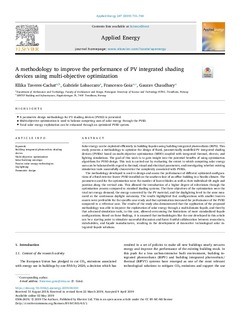| dc.contributor.author | Taveres-Cachat, Ellika | |
| dc.contributor.author | Lobaccaro, Gabriele | |
| dc.contributor.author | Goia, Francesco | |
| dc.contributor.author | Chaudhary, Gaurav | |
| dc.date.accessioned | 2019-11-13T08:02:24Z | |
| dc.date.available | 2019-11-13T08:02:24Z | |
| dc.date.created | 2019-05-29T16:44:12Z | |
| dc.date.issued | 2019 | |
| dc.identifier.citation | Applied Energy. 2019, 247 731-744. | nb_NO |
| dc.identifier.issn | 0306-2619 | |
| dc.identifier.uri | http://hdl.handle.net/11250/2628031 | |
| dc.description.abstract | Solar energy can be exploited efficiently in building façades using building integrated photovoltaics (BIPV). This study presents a methodology to optimize the design of fixed, parametrically modelled PV integrated shading devices (PVSDs) based on multi-objective optimization (MOO) coupled with integrated thermal, electric, and lighting simulations. The goal of this work is to gain insight into the potential benefits of using optimization algorithms for PVSD design. This task is carried out by evaluating the extent to which competing solar energy uses can be balanced with regard to thermal, visual and electrical parameters; and investigating whether existing simulation tools successfully characterize the complexity associated with PVSDs.
The methodology developed is used to design and assess the performance of different optimized configurations of a fixed exterior louvre PVSD installed on the southern face of an office building in a Nordic climate. The parameters used for the optimization were the number of louvre-blades as well as their individual tilt angle and position along the vertical axis. This allowed the introduction of a higher degree of eclecticism through the optimization process compared to standard shading systems. The three objectives of the optimization were the total net energy demand, the energy converted by the PV material, and the daylighting level in the zone measured as the continuous daylight autonomy. The results highlighted that configurations with smaller louvres counts were preferable for the specific case study and that optimization increased the performance of the PVSD compared to a reference case. The results of the study also demonstrated that the application of the proposed methodology was able to improve the exploitation of solar energy through a multi-domain façade, and thereby that advanced simulation tools, in this case, allowed overcoming the limitations of more standardized façade configurations. Based on these findings, it is assumed that methodologies like the one developed in this article can be a starting point to stimulate successful discussion and foster fruitful collaboration between researchers, stakeholders, and façade manufacturers, resulting in the development of innovative technological solar integrated façade solutions. | nb_NO |
| dc.language.iso | eng | nb_NO |
| dc.publisher | Elsevier | nb_NO |
| dc.rights | CC BY NC ND 4,0 | * |
| dc.rights.uri | http://creativecommons.org/licenses/BY-NC-ND/4.0 | * |
| dc.subject | Building integrated photovoltaic shading device | nb_NO |
| dc.subject | Multi-objective optimization | nb_NO |
| dc.subject | Solar building envelope | nb_NO |
| dc.subject | Passive solar energy technologies | nb_NO |
| dc.subject | Daylighting | nb_NO |
| dc.subject | Parametric design | nb_NO |
| dc.title | A methodology to improve the performance of PV integrated shading devices using multi-objective optimization | nb_NO |
| dc.type | Journal article | nb_NO |
| dc.type | Peer reviewed | nb_NO |
| dc.description.version | publishedVersion | nb_NO |
| dc.rights.holder | © 2019 The authors | nb_NO |
| dc.subject.nsi | VDP::Teknologi: 500 | nb_NO |
| dc.source.pagenumber | 731-744 | nb_NO |
| dc.source.volume | 247 | nb_NO |
| dc.source.journal | Applied Energy | nb_NO |
| dc.identifier.doi | 10.1016/j.apenergy.2019.04.033 | |
| dc.identifier.cristin | 1701451 | |
| dc.relation.project | Norges forskningsråd: 255252 | nb_NO |
| cristin.unitcode | 7401,30,40,0 | |
| cristin.unitname | Arkitektur, byggematerialer og konstruksjoner | |
| cristin.ispublished | true | |
| cristin.fulltext | original | |
| cristin.qualitycode | 1 | |

